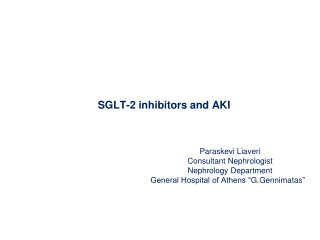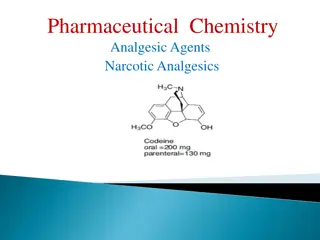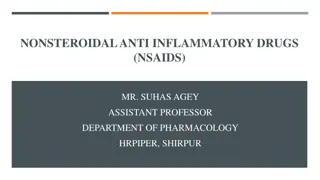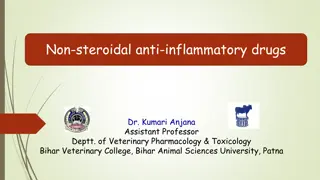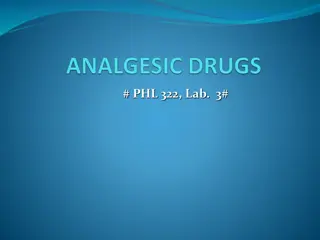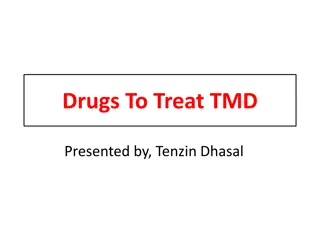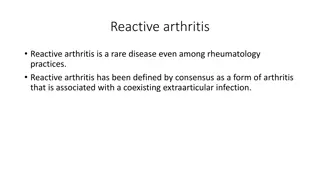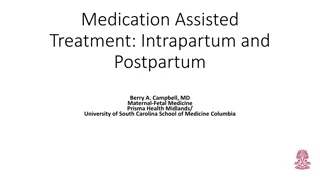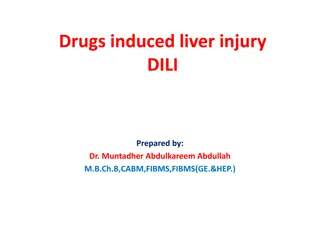
NSAIDs: History, Classification, and Mechanism
Explore the diverse world of NSAIDs, from their historical roots in White Willow bark to the modern classification based on chemical groups and COX inhibition selectivity. Learn about the beneficial effects and relative potency of NSAIDs, shedding light on their analgesic, anti-inflammatory, and antipyretic properties. Delve into the complexities of these non-narcotic drugs that act primarily on peripheral pain mechanisms while also impacting the CNS, all without the side effects associated with morphine. Uncover the evolution of NSAIDs and their impact on pain management strategies.
Download Presentation

Please find below an Image/Link to download the presentation.
The content on the website is provided AS IS for your information and personal use only. It may not be sold, licensed, or shared on other websites without obtaining consent from the author. If you encounter any issues during the download, it is possible that the publisher has removed the file from their server.
You are allowed to download the files provided on this website for personal or commercial use, subject to the condition that they are used lawfully. All files are the property of their respective owners.
The content on the website is provided AS IS for your information and personal use only. It may not be sold, licensed, or shared on other websites without obtaining consent from the author.
E N D
Presentation Transcript
StudyMafia.Org NSAIDs Submitted To: Studymafia.org Studymafia.org Submitted By:
Introduction History of NSAIDs Classification of NSAIDs Mechanism for NSAIDs Beneficial Effects of NSAIDs Relative Potency of NSAIDs Conclusion
NSAIDs are heterogeneous group of drugs having analgesic, anti-inflammatory and antipyretic effect. Unlike morphine they do not depress CNS, do not produce physical dependence, have no abuse liability and are weaker analgesics. They are also called non-narcotic, non-opioid or aspirin like analgesics. They act primarily on peripheral pain mechanism, but also in the CNS to raise pain threshold.
White Willow bark (Salix alba) had been used for many centuries. Salicylic acid was prepared by hydrolysis of the bitter glycosides obtained from White Willow plant. Sodium salicylate 1875 (pain and fever). Acetylsalicylic acid (aspirin) 1899 (Also phenacetin and antipyrine). Phenylbutazone 1949 (anti-inflammatory activity almost similar to corticosteroids), The term NSAIDs coined to designate such drugs. Indomethacin - 1963
Classification of NSAIDs based on chemical groups Salicylates : Sodium salicylate, Acetylsalicylic acid (aspirin), Methylsalicylate. Aniline or : Paracetamol (acetaminophen), Acetanilide, Phenacetin, p- aminophenol derivatives: Aminopyrine, Antipyrine. Pyrazolone derivatives: Phenylbutazone, Oxyphenbutazone, Sulphinpyrazone. Indole & related drugs: Indomethacin, Sulindac. Phenyl acetic acid derivatives: Diclofenac. Propionic acid derivatives: Ibuprofen, Naproxen, Fenoprofen, Ketoprofen. Fenamates: Mefenamic acid. Oxicams derivatives : Piroxicam, Tenoxicam, Meloxicam. Sulfonanilide derivatives: Nimesulide.
Classification of NSAIDs based on selectivity of COX Inhibition: Non-selective COX Inhibitors (Conventional NSAIDs): Salicylates: Aspirin, Diflunisal. Pyrazolone derivatives: Phenylbutazone, Oxyphenbutazone. Indole derivatives: Indomethacin. Propionic acid derivatives: Ibuprofen, Naproxen, Ketoprofen, Flurbiprofen. Anthranilic acid derivatives: Mefenamic acid. Aryl acetic acid derivatives: Diclofenac. Oxicam derivatives: Piroxicam, Tenoxicam. Pyrrolo-pyrrole derivatives: Ketorolac. Preferential COX-2 Inhibitors: Nimesulide, Meloxicam, Nabumetone. Selective COX-2 Inhibitors: Celecoxib, Rofecoxib, Valdecoxib.
A r a c h i d o n i c a c i d A r a c h i d o n i c a c i d COX-3 COX-2 (inducible)) COX-1 (normal constituent) CNS, Heart, Aorta (normal constituent) Selective COX-2 inhibitor Nonselective NSAID Normal Constituent CNC Kidney Female U/G tract Body homeostasis Stomach Intestine Kidney Platelet Inflammatory Site Macrophages Synoviocytes Endothelial cell Pain Fever Mechanism: COX-1, COX-2 & COX-3 inhibition
The prostaglandins are the mediation of inflammation. Inflammatory response is the body's natural response that occurs immediately following tissue damage. Most of the time NSAIDs are irreversible inhibitors of cyclooxygenase activity, thus they prevent the formation of prostaglandins and consequently reducing the signs and symptoms of inflammation.
Prostaglandins are a family of chemicals that are produced by the cells of the body in response to illness or injury. They promote inflammation, pain, and fever; support the blood clotting function of platelets; and protect the lining of the stomach from the effects of acid. Prostaglandins are unsaturated carboxylic acids, consisting of a 20 carbon skeleton that also contains a five member ring. They are biochemically synthesized from the fatty acid, arachidonic acid.
Analgesia Antipyresis Anti-inflammatory Antithrombotic Closure of ductus arteriosus in newborn
Normal body temperature is maintained by thermoregulatory centre (thermostat) in hypothalamus, which ensures a balance between heat production and heat loss. Fever occurs due to disturbance in the hypothalamic thermostat, which is set at a high temperature. The antipyretics act by resetting the thermostat to normal set-point and then the body temperature regulating mechanisms (dilatation of superficial blood vessels, sweating and increased respiration, promoting heat loss) operate to lower the elevated body temperature to normal level. Normal body temperature is not affected by NSAIDS or antipyretics (at therapeutic doses).
The inflammatory reactions such as vasodilatation, increased vascular permeability, cell proliferation, pain etc are mediated by the release of a multitude of chemical mediators having varied mechanisms of action. The inflammatory stimuli in the inflammatory cells induce synthesis of prostaglandins through COX2. The NSAIDS exert anti-inflammatory effect by inhibition of prostaglandin synthesis by irreversible inhibition of this enzyme.
The NSAIDS are mainly effective against pain associated with arthritis, bursitis, muscular pain, vascular pain, toothache, dysmenorrhoea and bone pain, in all the conditions there is increased synthesis of pain inducers and prostaglandins. The prostaglandins sensitize nociceptors to pain inhibiting prostaglangin synthesis through irreversible inactivation of COX-1 or COX-2 or both.
TXA2 is pro-aggregator (COX-1) PGI2 is anti-aggregator Most NSAIDs - effects on TXA2 predominates and inhibits aggregation prolonged bleeding time Aspirin is highly active and acetylates COX in circulation before hepatic 1st pass metabolism Even small dose Antithrombotic effect Myocardial Infarction and other cardiac conditions
It is a shunt connecting the pulmonary artery to the aortic arch Maintained by local PGE2 and PGI2 Closes at birth Failure to close small doses of NSAIDs (aspirin or indomethacin) closes. ( NSAIDs is not used in late pregnancy in late pregnancy premature closure)
Antipyretic Effect: Phenylbutazone Analgesic Effect: Aspirin > Phenacetin & Paracetamol > Phenylbutazone Anti-inflammatory Effect: Phenylbutazone > Aspirin Aspirin = Paracetamol > Phenacetin >
Generally, NSAIDs including COX-2inhibitors,diminish bone formation and therefore should be used as needed to decrease bone formation when desired but avoided when bone formation is the preferred outcome. NSAIDs appear to be beneficial for soft-tissue healing.
Google.com Wikipedia.org Studymafia.org Slidespanda.com



